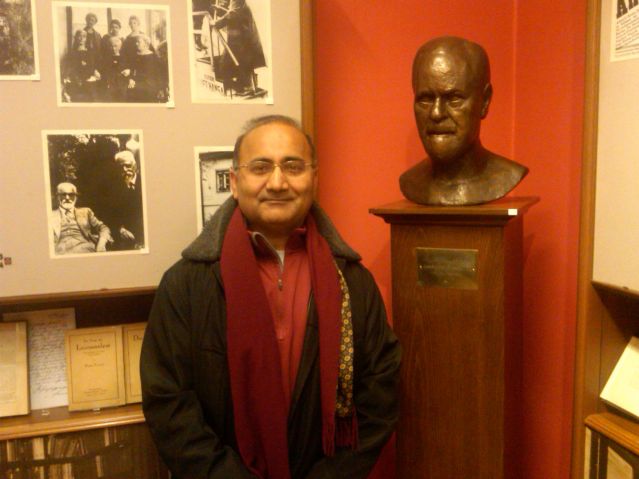Freudian Psychology
Freud's Tryst with India
Pioneering work of a psychoanalyst celebrates 'the opening of the Indian mind'.
Posted December 17, 2014
Freud’s tryst with India, continues....[1] Psychoanalytic theory has always been in a tension with the study of religion, on the one hand, and the analysis of culture, on the other. Ever since the publications of Freud’s seminal texts on these interconnected domains of human inquiry, “Totem and Taboo” (Freud, 1913)[2] “The Future of an Illusion” (Freud, 1927)[3] and “Moses and Monotheism” (Freud, 1939)[4], the debate about the conflict between the individual and the larger social and moral order has persisted. Now, as newer forms of individualism spread all over the globe in different gestalts and guises, the relevance of psychoanalytic interpretation of culture and religion may take on greater significance within a cross-cultural framework and as we examine various points of tension between the tradition bound segments of any population and the onslaught of modernity.

Globalization has shifted the economic center of gravity from the West to the East (i.e., China, India and the Pacific), while economic malaise knows no ends in European capitals, with low economic growth. As the East embraces a kind of crass materialism, while the West experiments with eastern spirituality of every kind, Kipling’s Victorian ballad has new significance:
“Oh, East is East, and West is West, and never the twain shall meet,
Till Earth and Sky stand presently at God's great Judgment Seat;
But there is neither East nor West, Border, nor Breed, nor Birth,
When two strong men stand face to face,
tho' they come from the ends of the earth!”
Sudhir Kakar, the leading Indian psychoanalyst, positioned himself at the borderland between East and West many years ago. More than sixty-five years after independence, as Indians are rediscovering themselves anew and embracing a fast-paced economic future, Kakar has come full circle in his own thinking about psychoanalysis and the Western enlightenment. “Decades later, no longer resonating to Nietzcshe’s call that every past is worth condemning, questioning my earlier idealizations of Western civilization and the Judeo-Christian tradition of which psychoanalysis, in spite of some differences in its image of man, is an integral part, I come back to Freud with some of the skepticism of the great skeptic himself” (Kakar, 2008, p. 136)[5].
Kakar has wrestled with tensions between religion and psychoanalysis within Indian studies and applied psychoanalysis, such that, the psychoanalytic study of culture and Hindu India have been fundamentally transformed. Yet, for the fundamentalist Hindu mind whether at home or abroad, Kakar’s work has opened up hidden zones and alleyways in the Hindu psyche that are best left unexplored or simply avoided. This is certainly the case with the Hindutva forces within and outside India.
His work has been ground breaking for many reasons. First, his thinking represents a syncretistic confluence of at least three streams of knowledge within the context of Indology and South Asian Studies:
-
Psychology: psychoanalysis and depth psychology and the study of lives across the life cycle and across different cultures, with a decidedly psychosocial or Eriksonian focus;
-
Anthropology: the study of culture and society in all its structural, symbolic and social formations, with an emphasis on the fit between culture and personality, as pursued by psychological anthropologists or cultural psychologists;
-
Religion: the study of religion with a special emphasis on the history of religious traditions, on the one hand, and praxis or religious practices, on the other, with a focus on healing traditions and the psychology of religious experience.
Each of these streams of knowledge and expertise have existed as separate disciplines in the history of Western thought with distinct genealogies stretching back more than a century, yet all of them have been applied towards understanding Indian or Hindu civilization with varying degrees of success.
Within the post-independence context of Indian social thought, Sudhir Kakar aligned these essentially Western knowledge systems towards interpreting the Indian or Hindu mind. The result of course was brilliant, with a full body of work that now spans the entire Hindu life cycle and a purview that includes religion, politics, literature and the arts. The power of his work stems partly from the fact that he has been able to weld these disciplines together for the first time in a consistent manner over almost a half-century.

[1] This blog is extracted from the edited book: Sharma, Dinesh. (2014). “Psychoanalysis, culture and religion: essays in honor of Sudhir Kakar” New Delhi/New York: Oxford University Press.
[2] Freud, Sigmund Totem and Taboo (New York: W.W. Norton & Co. 1913)
[3] Freud, Sigmund Future of an Illusion (New York: W.W. Norton & Co. 1927)
[4] Freud, Sigmund, Moses and Monotheism (New York: Vintage Books 1939)
[5] Kakar, Sudhir, Mad and Divine (New Delhi: Penguin 2008)


